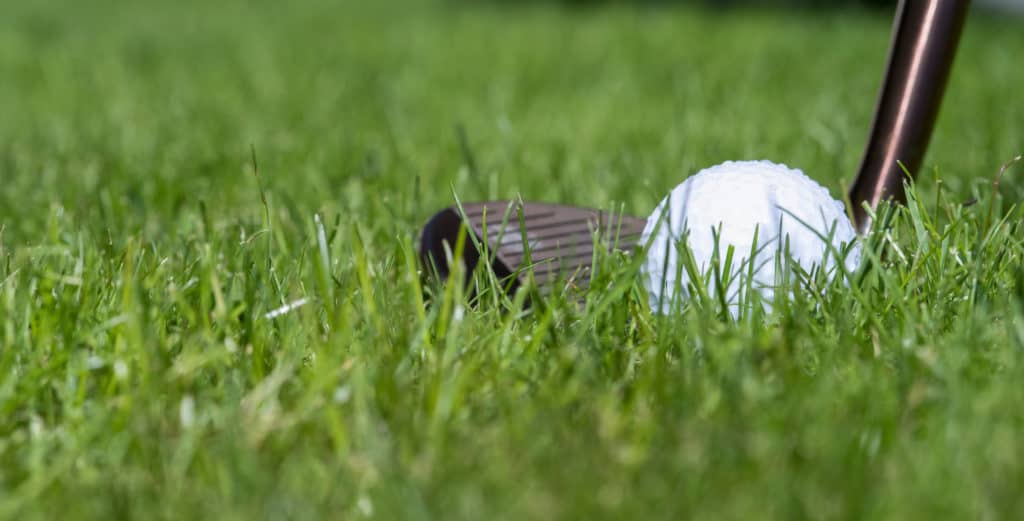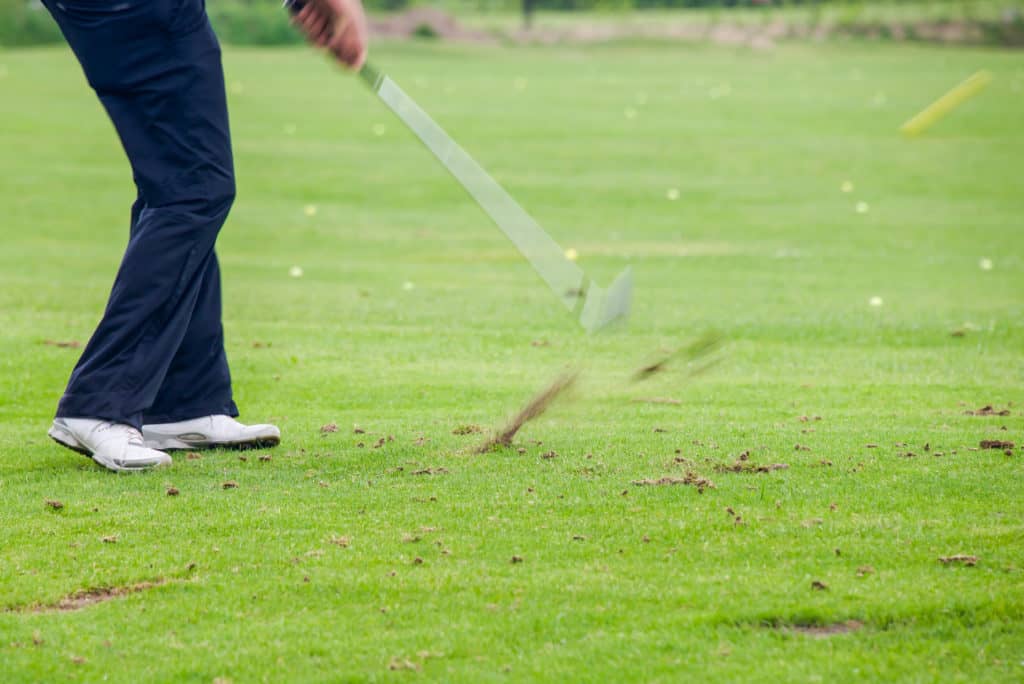Are you looking for a new method to chip the ball?
Maybe you have heard about using the bounce when chipping?
For years I chipped using the leading edge on the 60 degree lob wedge that I used and it worked pretty well. Overall, I was able to get the ball around the course when I missed the green and have success when chipping.
While there aren’t necessarily right ways or wrong ways to chip, sometimes there are easier ways to chip the ball.
Utilizing the leading edge is one option, while using the bounce is another option.
Is there one that is better? Not necessarily, you just find using the bounce when chipping an easier method.
So, I bring you 7 tips on how to use the bounce when chipping and maybe it can bring back some confidence to your short game approach and having confidence to get up and down to save more pars and keep that quality round going!

Using the Bounce When Chipping
Before we get into the tips, let’s first look at some of the common questions surrounding different chipping methods. Remember, there isn’t a best way, maybe just an easier way. At the end of the day, you want a method that provides you the results and the confidence over the ball to hit great shots.
Do The Pros Use the Bounce When Chipping?
If you watch any PGA Tour event you will see different methods of chipping. Someone like Phil MIikelson plays the ball either off his back foot for low shots or in front of the front foot if he wants some height in his chip shot. This method utilizes the leading edge.
Others on tour will use the bounce when chipping.
This is helpful when you have those tight lies in the fairway. The bounce on a club provides the club with the ability to move along the ground even it you slightly bottom out before the ball. If you are using a leading edge approach, with your hands forwards and you hit the ground before the ball, you will chunk the shot or lift up and blade it.
Should You Use the Bounce When Chipping?
If you are someone that is struggling with chipping and controlling the leading edge, then you should give this method for chipping a try. You might find that utilizing the bounce gives you a larger margin for error.
Resource: What club to use for chipping?

Advantages of Using the Bounce When Chipping
- Provides a great margin for error. The golfer can hit the ground slightly behind the ball.
- Allows for an athletic, underhand like motion to get the ball to the hole.
- Can be used with success out of any lie. Even those tight lies in the fairway are manageable.
7 Tips for Using the Bounce When Chipping
Tip #1: Set up with your hands even with the ball
When you complete your setup, your hands should not be forward pressed. If you were using the leading edge, then you would push your hands forward and keep your hands forwards throughout the shot.
When you are using the bounce when chipping, you will want your hands more even with the ball, to allow the club to set up naturally behind the ball. Every club has a certain amount of bounce in its natural loft. When you move your hands forward, you decrease the loft and bring the leading edge into play.
Resource: When to use a 60 degree wedge
Tip #2: Slightly hinge the right hand
In the backswing you will want to allow your right hand to slightly hinge on the back swing. Some golfers will use a swing where they try to keep everything very quiet. When using the bounce, it is fine to allow the hands to naturally hinge, without forcing the hinge. If you lock out your right hand in the backswing, you will not allow the hand to make that underhand motion through the golf ball.
Some might think this is a flip, but it is not. You keep your right arm moving.
Tip #3: Allow the right hand to move under the ball
Allow the club to pass your hand at some point and allow the hand to make a slight tossing or slapping motion under the ball. Once again, you are not holding anything off, let the shallow motion of the club sliding under the ball naturally happen.
Resource: When to use a 56 degree wedge
Tip #4: Keep your right arm moving
If you stopped your right arm and the hands kept moving, this would be considered a flip. Instead keep the right hand and body moving and allow the right hand to move under and through the ball. This is similar to an underhand toss of the ball towards the hole. It is a more natural movement.
You don’t feel restricted that you have to hold something off. Allow the natural motion of an underhand toss to take over. Your main thought should be to keep your right arm moving. As soon as the right arm stops, the hands flip and you bring the chunk or the bladed shot into motion. Keep your focus on the tossing motion and keeping that right arm moving.
Tip #5: Keep your eyes right behind the ball
When looking down at the ball, having confidence that you are going to allow the club to strike the ground even slightly before the ball. This gives you a higher margin for error without fear of chunking the shot or blading the shot over the green. This feeling can really bring some anxiety to chip shots. Instead, allow the club to strike slightly behind the ball, this is fine. The club is built to slide underneath the ball when you are using the bounce.
Tip #6: Feel the weight of the club
Keep your hands soft and feel the weight of the club. Any tension in your swing will cause you to tighten up and restrict the natural movement of the club. Remember, the key is an underhand tossing motion where the right arm keeps moving. Once your right arms stalls and lose the feel of the weight of the club, you will bring a poor result back into play. Allow the weight of the club to control the right wrist.
Tip #7: Flip the right hand
Yes, I heard you! But you want me to flip my right hand! Yes, but with your right arm in movement. Keep that right arm moving towards the target. Don’t be scared of ground contact. You are using the design of the club, that has plenty of bounce to allow it to slide underneath the ball even when you contact the ground. The extra flipping like feel at the bottom provides plenty of height. You may not have the same amount of spin, but the extra height will help stop the ball.
This is an underhand of slapping like motion. It happens more naturally vs forcing it at the bottom. Allow the weight to create the flip at the bottom and keep that right arm moving!

Next Steps: Using the Bounce When Chipping
Grab your highest loften club, hopefully a 60 degree lob wedge, which should have plenty of loft and head out to the practice green. Go ahead and put these 7 tips into play. Here is a quick bulleted list to help you.
- Setup with the club more even to the ball.
- Allow your right wrist to slightly hinge on the back swing.
- Allow your right hand to move under the ball like an under hand toss of what may feel like a slight flip.
- Keep that right arm moving. This is a major key!
- Eyes on the ball or slightly behind.
- Feel the weight of the club and allow it to hinge and unhinge your right wrist.
- Flip the right hand. Yes, allow the right hand to come underneath and up and through the shot.
Resource: What wedges should a beginner carry?
Take Action: Chipping Assessment
Do a before and after test on your chipping game and then continue to monitor over the next month! I would recommend the following assessment.
- Take one golf ball around a practice green and throw it to a random spot off the green.
- Go ahead and chip the shot and see if you can one putt.
- Repeat this for 20 different times, continuing to pick a random spot and then attempting to one putt.
- Track how many times out of 20 you can do this successfully.
- Complete this with your old chipping method and then repeat with utilizing the bounce.
- Go ahead and repeat daily for 30 days.
Do you find yourself getting better with using the bounce when chipping? What little feels or thoughts help you be successful? Go ahead and write those down or put into the notes on your phone and refer to them frequently to keep you on the right track!
Over time, the goal is to be able to complete this assessment at a 50% or higher rate. The average scratch golfer is able to get up and down (scrambling) at a 54% rate on average. The best PGA Tour players in the 70% range.
There might be times when a simple putting like motion might work best. Check out the resource below:
Resource: Chipping with a 9 iron (5 Tips)
Final Thoughts: Using The Bounce When Chipping
The end result is that you increase your margin for error when chipping. The most devastating thing in any golf round is the bladed chip shot that goes flying 30 yards past your target. Using the bounce when chipping allows you to increase the margin for error. If you catch the ball perfect, you will hit some great shots. If you hit the ground an inch or two before the ball, you will have a more average shot, but nothing devastating.
Resource: Golf Improvement Plan (7 Areas to Focus on)
You are allowing the weight of the club head to control the right wrist with the right arm still in motion. You are staying patient and do not need a lot of arm speed. Your contact feel may vary, but you will have a big margin for error and end up at worse with an average shot.
Chipping and short game is the fastest way to better scores. It doesn’t take speed, power or great athletic ability. This is one way to chip and worth testing out to see if it works for your game! Make sure you complete the assessment take action today!
I am an amateur golfer on a journey to get better, enjoy the game as often as possible and share my passion and knowledge with others. I have coached high school golfers at a high level and have a great passion for the game and want to give back. I enjoy learning about the golf swing and am currently studying to be a certified professional golf instructor. Join me in our journey to get better everyday. Thank you for reading!

